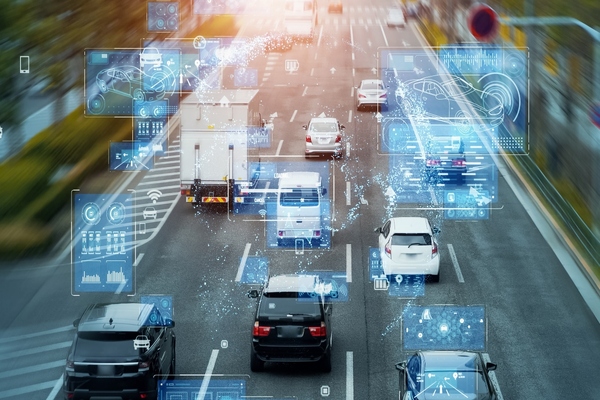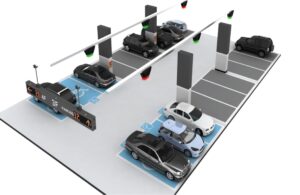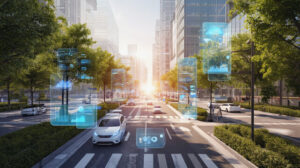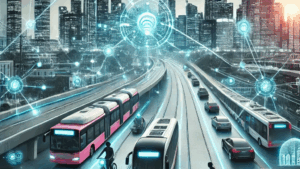The pressure on modern cities to provide sustainable, efficient transportation solutions is increasing. Smart public transportation systems are a new approach to urban mobility that uses cutting-edge technologies to revolutionize how people move around metropolitan areas. These intelligent systems combine real-time data, IoT sensors, mobile applications, and automated processes to create seamless and responsive transportation networks.
Smart Public Transport: Introduction
Smart public transportation represents a fundamental change from traditional transit models towards technology-driven solutions that prioritize efficiency, sustainability, and accessibility. These systems integrate different modes of transportation, such as buses, trains, trams, and ride-sharing, into cohesive networks that are managed by sophisticated software platforms. Smart systems collect and analyze data continuously to optimize routes, forecast maintenance needs, and improve passenger experience. Cities that have implemented these technologies report improvements in rider satisfaction, operational efficiency, and environmental impact.
Urban Mobility: The Evolution of Urban Mobility
In the last decade, urban transportation has seen a dramatic change. Transit systems rely heavily on manual dispatching and reactive maintenance, which often leaves passengers frustrated. Cities also struggle with overcrowding. The integration of GPS tracking and mobile connectivity with data analytics has revolutionized this landscape. Smart transport initiatives were pioneered by cities like Singapore, Barcelona, and Stockholm, which demonstrated how technology could reduce waiting times, increase safety, and increase ridership. This evolution reflects the broader urban planning trend towards sustainable development and services centered on citizens that use technology to solve complex metro challenges.
Smart Public Transport: Key Components
Smart transport systems that work well rely on several technological components interconnected and working together. Real-time tracking provides accurate vehicle location and arrival predictions. This allows passengers to plan their journeys more efficiently using mobile applications. IoT sensors track vehicle performance, load, and environmental conditions. They feed data to central management software that can dynamically adjust schedules and routes. Contactless payment systems simplify boarding procedures while also generating valuable analytics. Automated coordination of traffic signals ensures that public transport is given priority at intersections. This reduces travel time and improves service reliability. These components create integrated ecosystems in which data is seamlessly exchanged between vehicles, infrastructure, and passenger interfaces.
Smart Systems: Benefits and Implementation
Smart public transport systems have many benefits, beyond improving passenger satisfaction. The operational efficiency of cities increases as predictive maintenance reduces downtime for vehicles and optimizes routing to minimize fuel consumption. Improved vehicle utilization and integration of electric fleet technologies achieve reduced carbon emissions. Increased ridership, lower operational costs, and increased property values along transit corridors with good connections will bring economic benefits. Social benefits include increased accessibility for passengers with disabilities through improved information systems and enhanced safety via real-time monitoring. These benefits contribute to the overall livability of cities and their economic competitiveness.
Overcoming Challenges
Smart public transport systems present a number of challenges to which cities need to respond strategically. Initial investment costs are high, as they require significant capital to build technology infrastructure and train staff. Privacy and security issues require robust cybersecurity measures as well as transparent data governance policies. Integration of new infrastructure with existing infrastructure can be difficult, especially in older cities that have legacy systems. Communication strategies and education programs are essential to gaining public acceptance. The technical challenges include managing data quality and maintaining interoperability across different technology platforms. A successful implementation requires a strong political commitment, collaboration between stakeholders, and a phased deployment approach that allows for testing and refining.
The Future of Smart Public Transport
In the next decade, emerging technologies will continue to revolutionize public transportation systems. AI and machine learning will allow for more advanced predictive analytics. Autonomous vehicles will revolutionize service delivery, and 5G will provide real-time processing of data at unprecedented scales. Urban management systems, when integrated with smart city initiatives, will create a holistic system that seamlessly integrates energy, transport, and environmental systems. Mobility-as-a- Service platforms will dissolve the conventional distinctions between public and private transportation, providing passengers with a single digital interface to access a variety of transportation alternatives. These innovations will make public transportation more efficient and responsive to changing urban needs.
Building Tomorrow’s Interconnected Cities
Smart public transport systems are essential for sustainable urban development. Investing in these technologies now positions cities to spearhead the global transition towards more efficient and livable metropolitan areas. Collaboration between government agencies and technology providers is essential to ensure that solutions are tailored to meet the needs of citizens while improving service quality and environmental performance. Smart public transport systems are expected to play a more important role in the future of cities as urbanization increases worldwide.
FAQs
1. Why is public transport considered “smart”?
Smart public transportation uses technology such as GPS tracking, IoT sensors, and mobile apps to optimize routes and provide real-time data. It also improves passenger experience beyond the traditional fixed-schedule system.
2. What are the benefits of smart transport systems for passengers?
Passengers can now enjoy real-time arrivals information, mobile tickets, improved route planning, shorter wait times, and increased accessibility thanks to integrated mobile applications.
3. What are the major costs associated with smart transport?
Initial costs include software platforms, technology infrastructure, staff training, and system integration. Long-term savings and increased ridership due to efficiency improvements often offset these investments.
4. How does this system protect the privacy of passengers?
To protect passenger data and improve service, smart transport systems use data encryption, anonymization techniques, secure payments, and transparent privacy policies.
5. Can smart transport systems be used in smaller cities?
Yes, smart transport solutions that are scalable can be adapted to cities of any size. Smaller municipalities will often implement focused solutions such as mobile apps and real-time tracking before implementing comprehensive systems.




